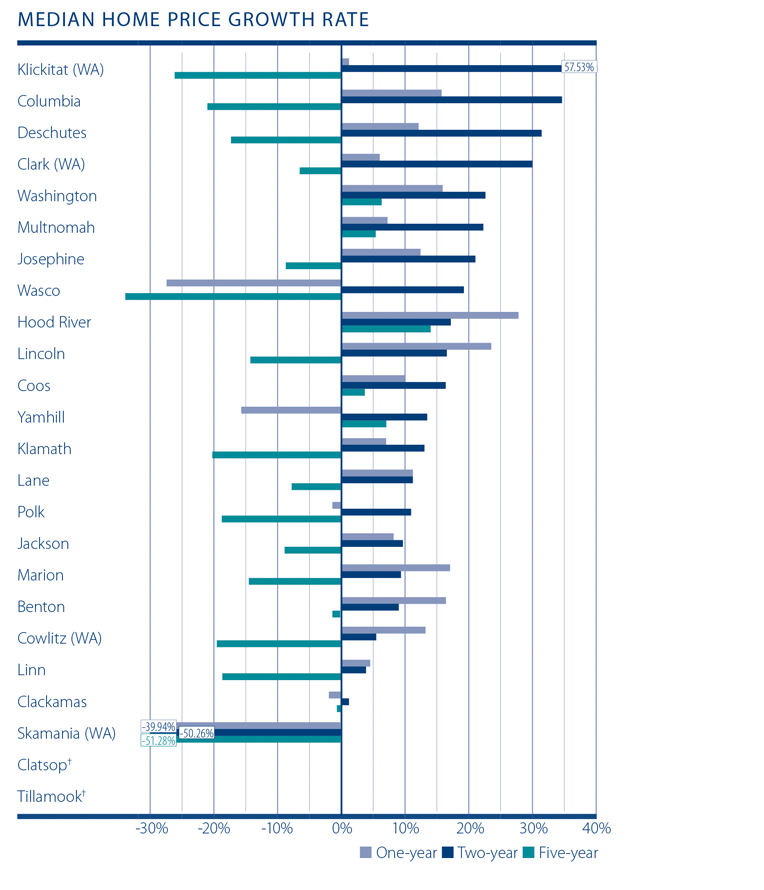Windermere Real Estate is proud to partner with Gardner Economics on this analysis of the Oregon and Southwest Washington real estate market. This report is designed to offer insight into the realities of the housing market. Numbers alone do not always give an accurate picture of local economic conditions; therefore our goal is to provide an explanation of what the statistics mean and how they impact the Oregon and Southwest Washington housing economy. We hope that this information may assist you with making an informed real estate decision. For further information about the real estate market in your area, please contact your Windermere agent.
Regional economics
The Oregon economy started to experience acceleration in job growth in 2013. This was largely expected as the housing market and industry rebounded, and the public sector cuts slowed across the state. As a result, more counties in the state began adding jobs. Now the question is whether the state can expect a further increase in the rate of growth.
The likely answer is yes. Early on in the recovery, the Portland metropolitan area was responsible for nearly all jobs gained statewide, but this changed in 2013. Although Portland certainly continued to add jobs at a steady rate, other areas, including Bend and Medford, began adding jobs as well.
In the past quarter, job growth in Bend and Medford has slowed as the nationwide housing rebound stalled. These markets are among the most heavily influenced by an influx of migrants and housing activity, so as the broader housing rebound slowed, so too did these and several other markets. This is supported by the fact that 13 out of the 24 markets analyzed saw employment losses in the fourth quarter of 2013.
It should be mentioned that overall employment growth did not decelerate along with the markets mentioned above, as private sector job gains in several markets accelerated to pick up the slack. All told, the market added 26,062 jobs in 2013, 7,704 of which came in the fourth quarter.
Looking forward to 2014, as regions within Oregon continue adding jobs, growth is likely to pick up a bit further, into the 35,000 jobs per year range, or an annual growth rate of 2.0 percent—up from 1.5 percent seen in 2013.
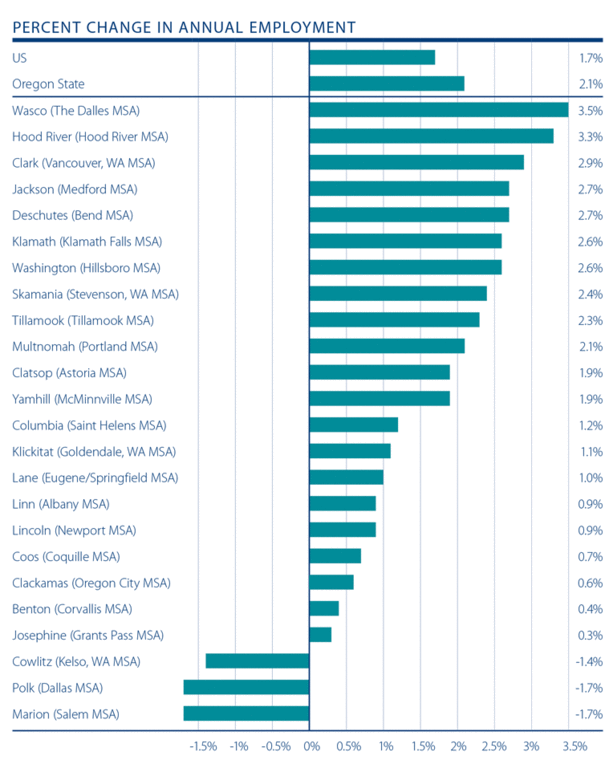

When compared to December of 2012, employment growth was most pronounced in the Wasco County area (+3.5%). This was followed by Hood River County (+3.3%), Clark County (+2.9%), and Deschutes and Jackson Counties which both expanded by 2.7 percent. On an absolute basis, Multnomah County maintains its position as the driving force behind job growth with the addition of 9,400 positions over the past 12 months. This was again followed by Washington County (+6,500) and Clark County where employment grew by 3,900 positions.
On the negative side, job losses totaled 3,388 in three counties. Almost all of the losses were seen in Marion County where employment dropped by 2,309 jobs. The other counties which shed jobs were Polk County (-579 jobs) and Cowlitz County (-500 jobs).
The unemployment rate continues to drop in every county that was analyzed—a trend that started in 2012. This is especially positive as there are now just two counties (Skamania and Klamath) where unemployment rates are still in double digits, at 10 percent.
Of the counties that saw shrinking unemployment rates, the greatest improvement was seen in Linn County where the unemployment rate dropped by two percent to 8.5 percent. This was followed by Deschutes and Josephine Counties where the rate dropped by 1.7 percent.
I am upping the “C-” grade that I gave last quarter to a straight “C.” As much as I anticipate an improving business environment in 2014, I want proof positive that we are seeing broad-based improvement before I get too excited about the job market.
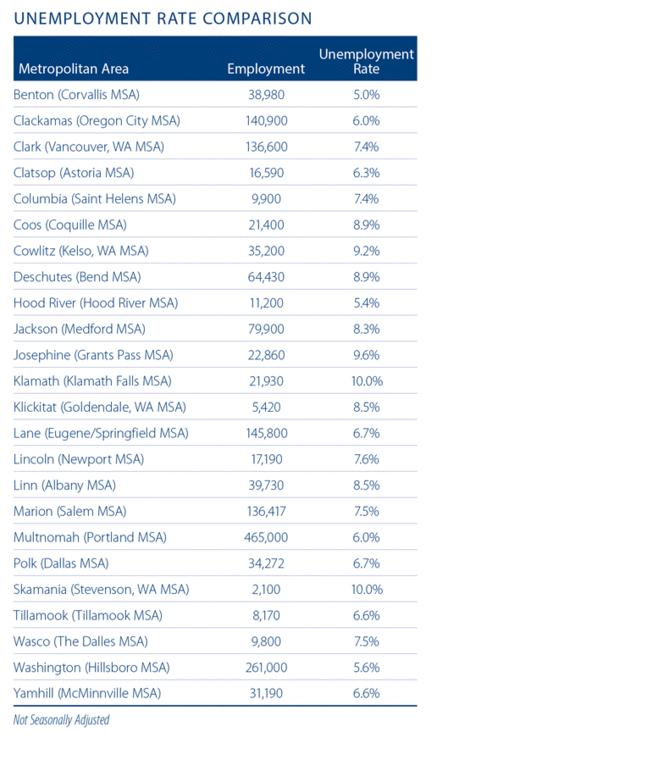
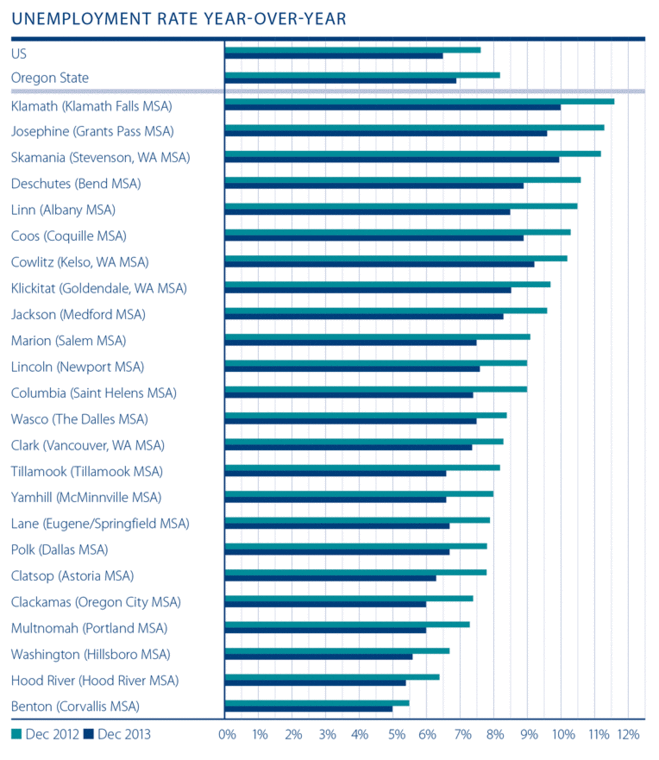
Regional Real Estate
In 2013, the region reported 48,819 home sales—an impressive increase of 13.3 percent over the figure seen in 2012 (43,100).
The rate of growth in sales was interesting, with fourteen counties registering double-digit gains, and two, Klickitat County and Cowlitz County, seeing growth of over 30 percent (33.3 percent and 35.4 percent, respectively).
Areas with the lowest increase in home sales were Linn County (+1.4%) and Josephine County (+4.5%). Other areas with somewhat modest gains were Polk County (+9.1%) and Marion County (+9.6%).
There were four counties where 2013 home sales did not exceed those seen the previous year. These were Deschutes County (-0.4%), Klamath County (-1.3%), Lincoln County (-2.1%), and Jackson County, where sales dropped by 6.3 percent.
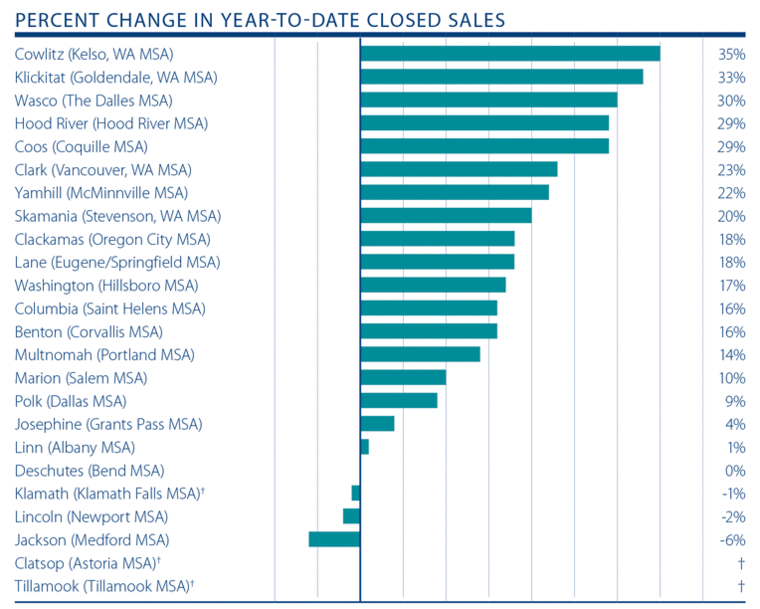

When we turn our attention to home prices, the picture was generally bright, with seventeen counties showing home values that were above those seen at the end of 2012 and eleven registering double-digit growth. In aggregate, the markets surveyed saw home prices rise from $243,919 to $263,888, an increase of 8.2 percent over 2012. This is a healthy rate of appreciation which, although lower than that seen through the third quarter, is indicative of a market that is starting to stabilize.
Looking at the individual counties, the most pronounced growth rates were seen in Hood River County (+27.9%)—unsurprising as this is a small market where average prices can make erratic moves. In addition to the county mentioned above, there were some impressive gains in value as demonstrated in the chart and table to the right. Six counties saw price increases below ten percent.
There were five counties where prices fell. Skamania County saw the greatest drop in value versus a year ago (-39.9%), but we again attribute this to the fact that it is a small market. The other markets where prices dropped were Wasco County (-27.5%), Yamhill County (-15.7%), and two others (Clakamas & Polk) registering very modest contractions of below two percent. I am not overly concerned about this as, if you average prices for the entire year, Yamhill and Skamania are both higher and Wasco is just modestly lower than a year ago.
As I mentioned in the third quarter report, the market continues to recover relative to price, but the rate of appreciation continues to slow. I was pleased to see that, when compared to two years ago, prices are almost uniformly higher. Again this is indicative of a market that is in recovery.
It was equally pleasing to see that there are now a few select markets where prices are above the level seen at the end of 2008, when we were just starting to see the housing bubble burst. I anticipate that, as we head through 2014, we will slowly start to see more counties turn positive when compared to five years ago.
I am still not ready to raise the grade for the real estate markets from the “C+” that I have given it for the past three quarters. Inventory levels are still nowhere near where they should be and I will be very interested to see if we get a much-needed spring “bump.” If we do, then I will become more confident in the stability of the market.
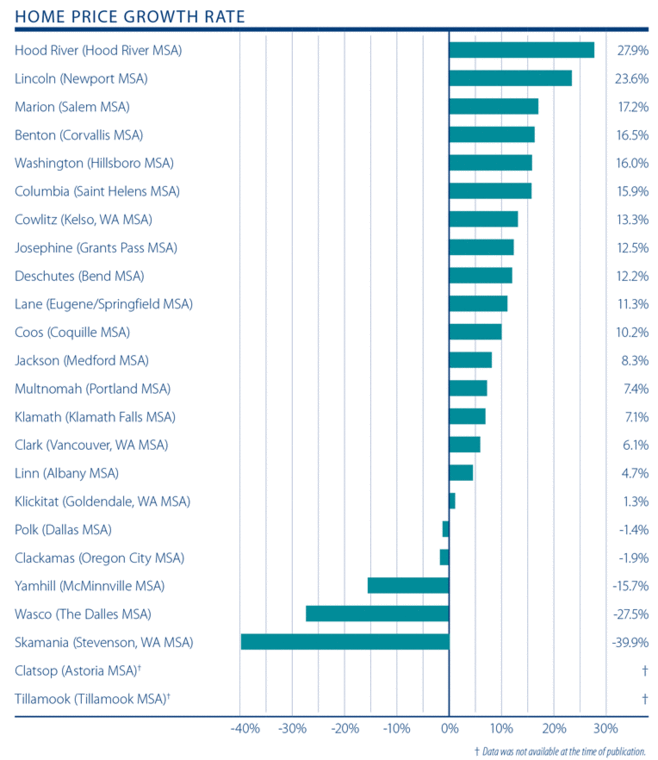

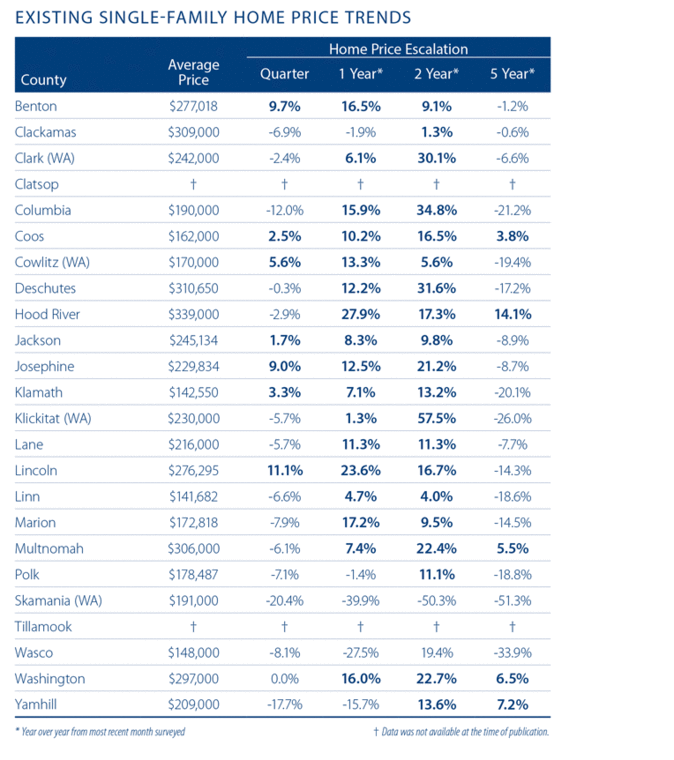
Conclusions
The Oregon economy, although still somewhat mired in the bog of lackluster growth, is starting to emerge with good job creation in the core employment centers and neighboring counties. This is encouraging.
In the markets covered by this report, employment growth has not yet started to outperform the state (1.51% vs. 2.08%) but is improving.
As I stated earlier in this report, I anticipate that 2014 employment growth should come in at around two percent. Not an overwhelming figure, but one that is an improvement over the growth rates seen over the past couple of years.
The housing market continues to head higher in terms of both price and sales volumes. The number of homes for sale in the region is still well below historic levels, but I remain hopeful that 2014 will bring a much-needed boost to active inventory.
While interest rates are certain to head higher this year, they will still be at very low levels when compared to historic averages. The average 30-year rate at the end of 2013 was 4.46 percent—just below the level seen in the summer of 2011. Although rates were in the threes in 2013, they are still very attractive when compared to historic standards. (Keep in mind that they hit 10 percent in 1990 and the market still functioned!)
Rates should rise modestly this year, but this does not really concern me. The limited number of homes for sale is—by far—more worrisome. I remain hopeful that we will see higher inventory levels in 2014, which should offset worries over increasing rates.
About Matthew Gardner
 Mr. Gardner is a land use economist and principal with Gardner Economics and is considered by many to be one of the foremost real estate analysts in the Pacific Northwest.
Mr. Gardner is a land use economist and principal with Gardner Economics and is considered by many to be one of the foremost real estate analysts in the Pacific Northwest.
In addition to managing his consulting practice, Mr. Gardner chairs the Board of Trustees at the Washington Center for Real Estate Research at the University of Washington; sits on the Urban Land Institutes Technical Assistance Panel; is an Advisory Board Member for the Runstad Center for Real Estate Studies at the University of Washington; and is the Editor of the Washington State University’s Central Puget Sound Real Estate Research Report.
He is also the retained economist for the Master Builders Association of King & Snohomish Counties. He has twenty-five years of professional experience in the U.K. and U.S.
He has appeared on CNN, NBC and NPR news services to discuss real estate issues, and is regularly cited in the Wall Street Journal and all local
 Facebook
Facebook
 X
X
 Pinterest
Pinterest
 Copy Link
Copy Link
